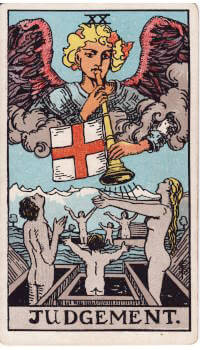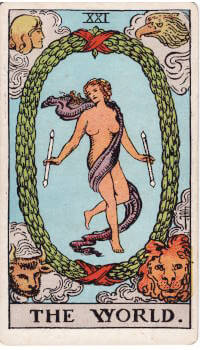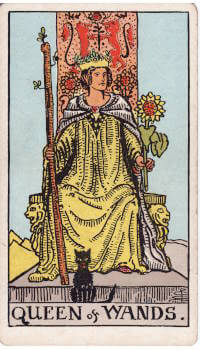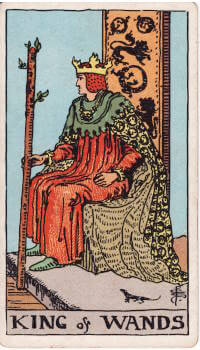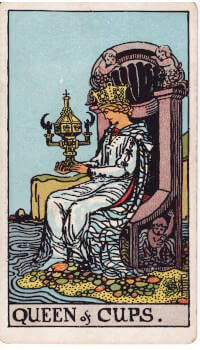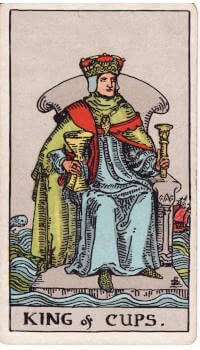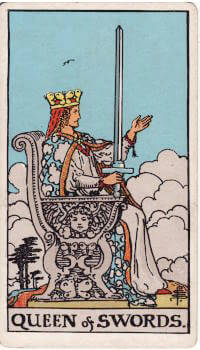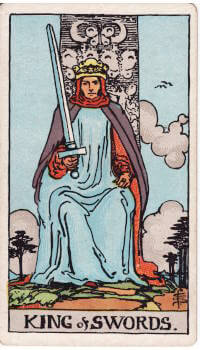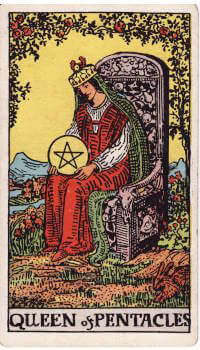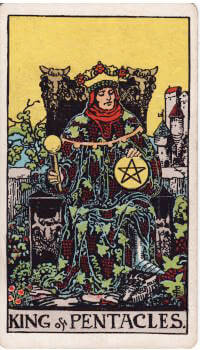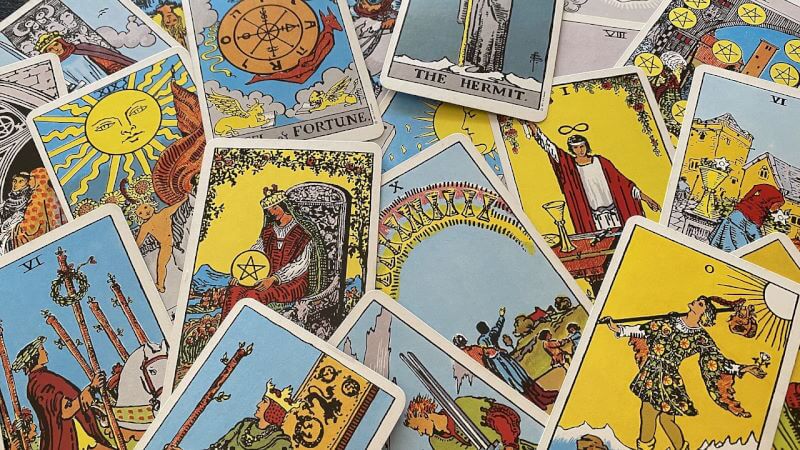
Tarot: A Complete Beginner’s Guide
Tarot cards – getting started
The name Tarot evokes mixed reactions – for some, an unusual pastime activity; for others, merely one of the numerous ways in which fake mystics rip money off of the naïve; for yet others, an important divination tool. Indeed, most people have some vague idea about it. You might have seen the cards, let’s say, in a TV show; you may know that some people use them to foretell the future, or perhaps you just heard about their existence. Even if the title of this article is the very first time you see the name Tarot, it doesn’t matter. We’re here to help dispel the numerous misconceptions about the cards that revolve around the web. Regardless of whether you already know something about Tarot and want to supply your knowledge, you have just been given a strange-looking deck of cards and have no clue what to do with it, or whether you’re looking for some information out of sheer curiosity – this article will answer whatever questions you, being a beginner, might have with regards to Tarot.
The Tarot deck and its components
Let’s start with the most fundamental information – the deck’s composition. There are 78 cards in total, i.e., 26 more than in the “standard” decks that you’re most likely used to. The Tarot deck consists of two parts, known as Major Arcana and Minor Arcana. If you have any experience with the standard French-suited or the Spanish-suited deck of playing cards, you will find Minor Arcana familiar. Minor Arcana has four suits identical to the Spanish-suited deck: Wands (or Batons), Pentacles (or Coins), Swords, and Cups. Much like the standard French-suited deck, each Minor Arcana suit contains numbered cards ranging from 2 to 10, along with an Ace. Additionally, each suit also contains four court cards (or face cards): the Page, the Knight, the Queen, and the King. Summing up all the cards, we come up with 56 cards comprising the Minor Arcana. This Arcana’s apparent similarity to the French- and Spanish-suited cards is not coincidental, as they both derive from the same source (you can read more on that in the section “History of the Tarot cards”).
As for the Major Arcana, it is a uniquely Tarot trait.1 There are no suits there, as each card is unique. Instead of the suits, each card is assigned a Roman number from 1 to 21 in the order presented below. If you don’t know how Roman numerals work, check out our article on how to switch between Roman and Arab numerals.
- I. The Magician
- II. The High Priestess
- III. The Empress
- IV. The Emperor
- V. The Hierophant
- VI. The Lovers
- VII. The Chariot
- VIII. Strength
- IX. The Hermit
- X. Wheel of Fortune
- XI. Justice
- XII. The Hanged Man
- XIII. Death
- XIV. Temperance
- XV. The Devil
- XVI. The Tower
- XVII. The Star
- XVIII. The Moon
- XIX. The Sun
- XX. Judgement
- XXI. The World
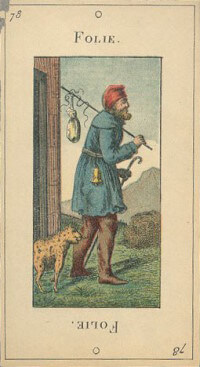
You might’ve noticed that we’re still one card short, right? The last one is The Fool (Figure 1), which is traditionally unnumbered. It has not always been so, as the card was given various numbers (most often 0) in the occult tradition. The fact that the Fool is left without a number is also uncoincidental, as it stands in an interesting relation with the other cards of the Major Arcana. The Fool is us; it represents any given individual, whereas the Major Arcana are life itself – the Fool undertakes a journey, depicted by the Major Arcana, meaning that Major Arcana are actually allegories of our own lives.2
History of the Tarot cards
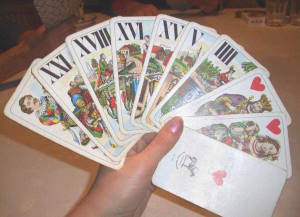
So far, we have discussed Tarot only in the context of divination, and for the right reason since that is what Tarot signifies for most people today. We do not usually think of these cards as being used for some sort of game (Figure 2), as is often the case with French-suited cards, but in fact, there exists a game of Tarot. At their inception, Tarot cards were not suspected of having any supernatural powers; they were merely used to play a parlor game, which later evolved into an entire family of games.3 Some of these games are still popular today – but let’s start from the very beginning.
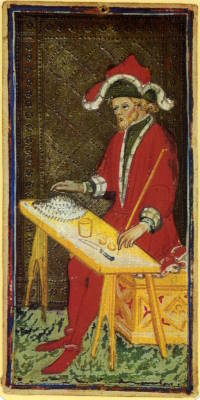
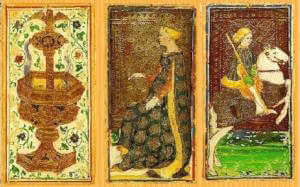
Although Tarot is rumored to have originated in antiquity, its ancient origins are shrouded in mystery. Its documented history began in the 15th century: traces of cards from that period, known as tarocchi (from which today’s name Tarot comes) or carte da trionfi (the trump cards), were found in Northern Italy, specifically Milan, Ferrara, Bologna, and Florence.4 Notes from between 1418 and 1425 that mention the commissioning of a tarot-like deck of cards have survived up to this day.5 Still, the deck itself has not survived the test of time. The first decks, which are unambiguously Tarot, are dated to 1440-1450 and are today known as the Visconti-Sforza Tarot (Figure 3 and Figure 4), after the names of Filippo Maria Visconti and Francesco Sforza, members of the Renaissance Milanese nobility, who commissioned them.6 No complete deck survived until today. However, out of the approximately fifteen decks, of which remnants were found, three consist of over fifty cards, giving us more than a solid idea of the characteristics of these early cards. The fact that they were made between 1440 and 1450 suggests that the cards and the game for which they were used must have been known for at least a few years (maybe even decades) before 1440, but here we enter the realm of guesswork. The statement that Tarot cards have been known since the mid-15th century must suffice for our purposes.
The fact that we find the first mentions of Tarot in that specific time and place, i.e., 15th-century Italy, should come as no surprise. Playing cards first appeared in Europe in modern-day Italy and the Iberian Peninsula. Europeans living at the cusp of the Middle Ages and Renaissance borrowed them from the Moors, who, in turn, brought them from Egypt, specifically the Mamluk Sultanate.7 The similarity between the Mamluk cards and early European cards is easily visible once we analyze the suits, which, in the case of Tarot, remained almost unchanged until today. The Mamluk cards contained the suits of Cups, Swords, Coins, and Polo Sticks. The last one was then changed to Clubs, as European cardmakers were unfamiliar with the game of Polo, and then further evolved into Wands, which we see in today’s Tarot decks.8
The newly introduced Visconti-Sforza deck and the game it was used for must have made quite a career in Italian cities because, by 1450, cardmakers began to produce cheaper, printed copies of the cards the nobility had previously been commissioning.9 Doing so also allowed the less affluent classes to engage in the game, leading to its quick spread. Nonetheless, the cards were used mainly to play parlor games back then. Although the names and figures on the cards that constitute the Major Arcana provide a gateway to the search for putative occultist connections, the first mentions of people looking for them come from the 18th century.
Fast forward to the 21st century, and we see that the card game is still alive and well. Despite the fact that Tarot is mostly associated with the occult, the games have not been forgotten. Conversely, Tarot cards are used simultaneously for both purposes.
Now that we have learned so many meanings of the word, what then is Tarot today? The name denotes the deck of cards used both for divination and parlor games. However, it may also mean one of the games played with these cards, for instance, the French Tarot or Königrufen. These games are indeed quite popular in the francophone sphere. It is reportedly the second most widely played card game in France, as in some parts of Switzerland.10 It somewhat resembles Contract Bridge and is, likewise, a trick-taking game. If you want to learn more about the game, you can watch a tutorial on YouTube.
Foundations of Tarot cartomancy
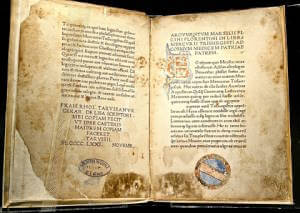
How did it happen that Tarot started to be used for divinatory practices? To answer this question, we must examine the changes Tarot underwent in 18th-century France. Perhaps Dummett, Decker, and Depaulis have the best answer as to why this specific place and time constituted an ideal ambient for the occultist Tarot to spring up. According to them, the advent of the Romantic era (roughly the end of the 18th century) brought about an increasing interest in various forms of mysticism, Hermetism, and widely understood “ancient lore” (Figure 5 shows an important text for the contemporary mystics). People wanted to explore things that were seemingly beyond the scope of rational cognition alongside ancient civilizations and the knowledge their writings might contain.11 As it happens, the French were particularly active in developing such esoteric sentiments.
Out of all the different elements of ancient lore, three influenced the development of Tarot occultism the most, namely a craze for ancient Egypt (mind that the hieroglyphs had not been deciphered yet)12, Hermetism, and Kabbalism (a school of thought in Jewish mysticism). In an environment that prevailed in 18th-century France, it was very likely that a deck of cards of unknown origins and captivating illustrations would prompt people to come up with all sorts of theories about its use and origin.
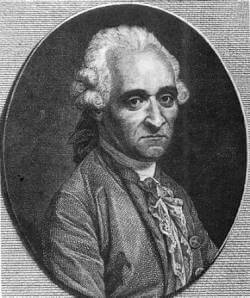
One may suspect that such a major piece of Western magic as the occult Tarot must have developed over decades or even centuries due to the influence of various writings and schools of thought. However, in reality, the entire tradition may be boiled down to the ideas of a single person – Antoine Court de Gébelin (Figure 6), a Protestant pastor, a freemason, and a savant. His first encounter with a deck of Tarot cards occurred at some point between 1773 and 1778, and it happened by pure chance. By his own account, Court de Gébelin was invited to visit one of his acquaintances, denoted only as “Madame la C.,” along with some other people. There, they found her occupied playing a card game, “which you surely do not know.” Indeed, the guests had no notion of the game at all, but what caught their attention was not the game itself but the deck she used. The guests ran through the cards, discussed them, and declared that their origins must be Egyptian.13
Court de Gebélin was so enthralled by the cards’ imagery that he did not stop at this assertion only. He went on to call the deck “an Egyptian Book escaped from barbarism, from the ravages of time, from accidental and deliberate conflagrations, and from what is even more disastrous, ignorance.”14 For him, the Tarot deck was literally a book which passed on the knowledge of the ancient Egyptians in the form of allegories. It survived the “ravages of time” precisely because of the inconspicuous form of its compilation. A deck of cards was easy to replicate and disseminate. At the same time, heavy reliance on symbolic imagery hid its true meaning from successive generations. Even the name of the deck and game was supposed to be of Egyptian origin; Tarraux, claims Court de Gebélin, older French orthography of the word Tarot, is actually derived from Egyptian Tar and Ros, meaning “royal road.”15 As you might expect, deciphering hieroglyphs several decades later proved this reasoning to be nothing but the author’s fabrication. Still, at that time, it couldn’t make much difference. Occult Tarot had already taken its root and began to grow into what would become one of the most popular elements of Western magic.

![Engraving of Mercurius [Hermes] Trismegistus from Pierre Mussard, Historia Deorum fatidicorum, Venice, 1675. Wikimedia Commons, public domain.](8-engraving-of-hermes-trismegistus-from-pierre-mussard-historia-deorum-fatidicorum-250-298.jpg)
The following decades (or, in fact, the entire 19th century) have brought about a considerable development of de Gébelin’s initial ideas. His proposals for the actual meaning of Tarot cards quickly became a subject of discussion among other individuals with a knack for occultism. After de Gébelin first mentioned Tarot cards in his voluminous work, Monde primitif (Figure 7), count Mellet produced an essay on the topic, which was then included in volume VIII of the said book. Mellet, however, went a step further in his assertions. For instance, he envisaged the name Tarot to mean “doctrine of Thoth,” so naturally, Tarot must have been the mythical Book of Thoth, which summarized the philosophy of Egyptians.16 Thoth was the ancient Egyptian god of knowledge, science, and writing. Yet, de Mellet identified him with a legendary sage named Hermes Trismegistus (Figure 8), an ancient figure combining the qualities of Thoth and the Greek god Hermes since they are each other’s counterparts in their respective cultures. Linking Tarot with Hermes Trismegistus was, without a doubt, deliberate – the collection of texts reportedly written by him gave rise to an entire philosophical system, Hermetism, which was quite popular among the occultists of the time. Moreover, de Mellet divided the Major Arcana into three sets of seven cards (excluding the unnumbered Fool). This operation was very convenient since seven was a sacred, mystical number for the Kabbalists. Thus, the first connections between Hermetism, Judaic philosophy, and Tarot were made.17
However, de Mellet’s biggest credit in developing Tarot cartomancy (foretelling the future through card reading), lies not in all of his (rather far-fetched) assertions about the deck’s origins but in the fact that he was the first ever to illustrate a layout of the cards and interpret their meaning, which pertained to the Pharaoh’s dream about seven fat and seven lean kine, a motif known from the biblical Genesis. He then expounded on an entire method of selecting the proper cards and reading them, laying the cornerstone for the practice of future tarotists.18
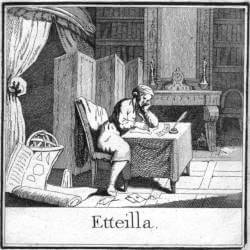
Among the pioneers of Tarot cartomancy one more person deserves mentioning. Jean-Baptiste Alliette (1738-1791), better known under his pen name Etteilla (Figure 9), could be credited as the first professional card reader. A tarot deck he designed and arranged in order he deemed correct is still produced and available for purchase to this day. Besides, he coined the French term for “cartomancy,” cartonomancie, which later spread into other languages, including English. Etteilla was also the first to publish full-fledged books on Tarot, in which he tried to further elaborate the theories of Tarot’s ancient Egyptian provenance. Although, as already mentioned, the first connections between Tarot and all sorts of other mystical “sciences” and philosophical systems were drawn sometime before Etteilla by his compatriots, he was actually the first to try to incorporate Tarot into a larger system of “magic theory,” wherein Tarot was merely one of the components, alongside astrology, the study of the cardinal elements (water, earth, fire, air), numerology, and others. Finally, Etteilla had a lasting influence on developing Tarot occultism due to his numerous followers, who pushed the “discipline” further on in the early 19th century.19
Another reformer of the occult Tarot, the last one to occupy us here, went by the name of Alphonse-Louis Constant but became widely known as Éliphas Lévi. The pen name is simply a Hebraized version of his name “Alphonse-Louis.” Lévi’s biographies invariably mention that two widely divergent periods marked his life; during the first, he was devoted to pursuing priesthood and, later, the life of a monk, but spiritual crises and disillusionment with the Catholic Church led him to seek a new meaning of life in occultic and esoteric circles.20 That’s where he developed his ideas about Tarot, which we briefly summarize here.
Lévi’s role in the history of Tarot revolves around the fact that he revived it. This could be said not only of Tarot but of occultism overall, with Tarot as one of its components. Around 1852, when “high magic” caught Lévi’s attention, the occult tradition was faltering. Its various elements, present in the Western world since the Renaissance, were quickly being abandoned and forgotten.21 Unsurprisingly, this coincided with the decline of the Romantic era and the advent of Positivism, which sternly discouraged any practices that deviated from pure logical reasoning and empiricism. However, Lévi’s writings had a large potential to appeal to the masses. In contrast with Etteilla, Lévi did not try to style himself as the possessor of some ancient knowledge passed on from masters to apprentices throughout centuries within the confines of secret societies. In his own words, he was just a “poor and obscure scholar [who] has found the lever of Archimedes, [offering] it to you for the good of humanity alone, asking nothing whatsoever in exchange.”22 He did not command any austere self-discipline nor did he require anyone to abandon their faith – he just explained what he had learned and did not try to go beyond that.
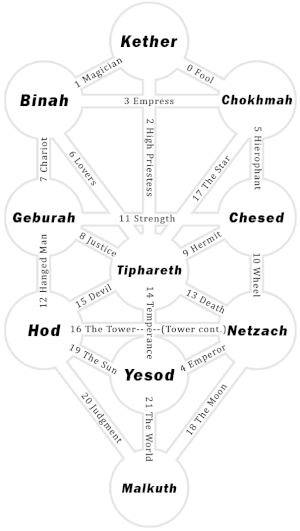
Lévi’s writings were not too original, save for returning to and perfecting the idea of Tarot being connected to Kabbalah (Figure 10) by linking each Major Arcana card to corresponding Hebrew letters, which are in turn dense with symbolism in the Kabbalistic tradition. The strength of his writing derives from completing a successful and straightforward synthesis of all the most important elements of Western occultism. In Lévi’s system, everything is intertwined; neither Tarot nor any other component of “high magic” (e.g., astrology or alchemy) could be treated separately from the rest. To sum it all up, Lévi’s greatest achievement was not concerned with developing the theory of Tarot as such but with forming a synthesis of Western occultism centered on Tarot; “Lévi’s writings indeed formed the channel through which the Western tradition of magic flowed down to modern times.”23
Tarot and psychology
Thus, is it so today that Tarot divination is nothing but a fun diversion with no practical use? After all, that’s what you may be thinking after being acquainted with the history of Tarot cartomancy, evidently riddled with unconfirmed theories. Or maybe there’s still something we may draw from reading Tarot cards? Although the occult tradition of the cards contains statements problematic to defend if we account for the knowledge we possess today, numerous psychologists believe we still may learn from the Tarot.
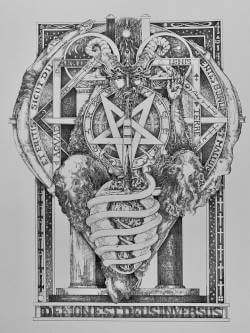
Some people are skeptical about the fortune-telling aspect of the deck. Still, even they acknowledge its benefits as a self-exploratory tool. The key thing is we should not treat Tarot readings as a conduit for divination but as an intermediary allowing us to peer into our innermost intuition and subconsciousness. Carl Gustav Jung himself admitted that Tarot cards represent psychological and symbolic imagery, stimulating the subconsciousness (Figure 11). The cards, said Jung, combine in ways that correspond to the development of humankind. He associated the symbolic representations on the cards with his theory of archetypes, i.e., universal ideas and patterns of thoughts present in the collective unconscious of each individual. Thus, Tarot’s imagery “speaks” to all of us since we share the same innate mental ideas.24
As Rachel Howe, a well-known Tarot reader from New York, describes, the practice is not really some magical or occult activity but rather a conversation between the reader and the person whose cards are being read. Consider it a discussion that’s simply facilitated by the cards and the symbolic meanings they convey: “Tarot, a tool, and the real healing work is going to be done by the person,” says Howe. “A lot of people describe tarot as a mirror, so it’s not like I’m pulling some secret out of you.”25
Jung and Howe imply that as long as we keep an open mind and remain willing to try a different approach to understanding our psyche, Tarot could be helpful in our daily lives. Interpreting the cards in juxtaposition with our current experiences, feelings, doubts, and fears might reveal some truths about ourselves that we might not be aware of or simply be unwilling to accept. Think of it as a conversation with a close friend who knows you really well but can interpret what you’re going through from the “outside.”
Getting to know the cards
The very first thing to remember is that anyone’s adventure with Tarot is a highly personal process. There is no single unified, step-by-step guide that everyone should follow. Bear that in mind whatever you do with the cards. The most important thing is that you, and only you, feel that what you’re doing is correct and that you’re heading in the right direction. Nonetheless, such truisms might be frustrating for beginners who have no clue how to proceed and wish there were someone to guide them through the process, at least initially. Here, we present some useful tips on getting started so that you don’t feel abandoned entirely in your journey and, consequently, discouraged from the very beginning.
If you simply cannot wait to begin spreading the cards and reading their messages, you may want to skip this section and dive straight into the next one. If you’re patient enough to go through the more structured, organized process, bear with us.
Most experienced tarotists recommend doing the following: once you get your first Tarot deck, begin (or end) each day with a simple exercise. Think of what awaits you during that (or the next) day, how you feel about the upcoming challenges, and what you should beware of. Most importantly, try to remain relaxed and calm. Then, shuffle the cards (both Arcanas!) and pull one of them out. Just one. Look at it, try to interpret the imagery depicted on it, and perhaps meditate for a while in its vicinity. Some people like to write down what they’ve got along with their interpretation in a journal. Try to look for some clues in the imagery and think about what the card might be telling you about the situation you’re currently in. Consider anything that draws your attention. Let your intuition do the work for you – the first thought is usually the most important. Think of the card you’ve drawn as your day goes by. Do you see any links between what you’ve read from the card and what is happening or how you feel? Try not to think too intently on the card’s meaning; don’t try to force any connections. Instead, let your spontaneous thoughts speak to you whenever they might appear.26
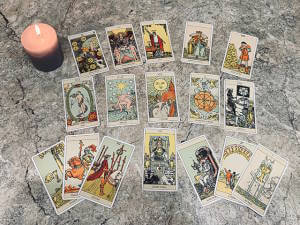
Repeat that for as long as you wish, preferably long enough to have a chance to go through all of the cards. After some time, you may start to draw two cards at a time, thus looking for connections between them to see how different cards complement one another. It is a lengthy process, but it helps immensely in reading the cards later once you begin to deal more complicated spreads (Figure 12). After some time, you should be able to notice that you’re becoming more and more familiar with the cards, that they evoke interpretations faster, and that the way you perceive them changes. This learning process is particularly evident when one decides to have a tarot-reading journal along the way, in which they write down how the process develops.
The cards’ meanings
Before you familiarize yourself with the meaning of each card, make sure you know the most important fact regarding the interpretations – it should be, first and foremost, subjective. No prescribed interpretation should overshadow how you feel about a given spread and how it relates to your life at the moment. The most important is what you see and think. Nonetheless, this is a beginner’s guide, and beginners usually feel the need to learn the meanings of cards before they start to read out the cards on their own. Thus, feel free to learn from our overview of the cards’ meanings, but don’t forget to use your imagination and follow your intuition. Only intuition will make Tarot work in the most valuable way, i.e., as a tool of self-reflection.
Although the two Arcana form a single deck and should always be used together, it is instantly visible that they are two very different entities. Whether in a Tarot-based parlor game or card reading, Major and Minor Arcana have their specific, largely diverging roles. When it comes to divination, the main difference lies in the fact that these two sub-sets pertain to various aspects of life. Since Major Arcana represent the Fool’s journey, their symbolism centers on this journey’s – our own lives’ – significant events. These 22 cards give us insight about the central, life-shaping experiences. As Jung acknowledged27, Major Arcana represent the universal archetypes, and so as such, it is an allegory of the search for our true selves, our purpose, and the moments that define us as humans. On the other hand, Minor Arcana refer to our everyday activities, the standard fare that makes up most of our lives. Accordingly, this sub-set is larger and has less complex symbolism – the 56 cards comprising it don’t offer as many interpretational possibilities as Major Arcana. Minor Arcana reflect the daily ups and downs, focusing on our physical and emotional conditions on a smaller, down-to-earth scale, which contrasts sharply with highly symbolic and salient information provided by the Major counterpart.
After you’ve ingested that much information about the deck and its history, the time has finally come to learn what specific cards mean. Let’s begin with what probably interests you more: the Major Arcana. Hover your cursor over the card that interests you and check what it means, both in the upright and reversed position!28
Major Arcana
0 – The Fool
New beginnings, caring for your inner child, spontaneity, light-heartedness, innocence
Immaturity, lack of discipline, carelessness, laziness, irresponsibility
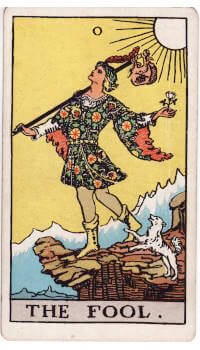
I – The Magician
Taking action, being the leader, strong will, self-development, vitality, risk-taking
Indecisiveness, fear, low self-esteem, shyness, apathy, mental restlessness
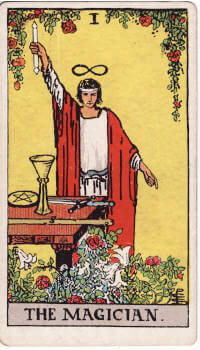
II – The High Priestess
Intuition, wisdom, inner peace, reaching your unconsciousness, security
Passivity, complexes, fatalism, neurotization, withdrawal from reality and social life
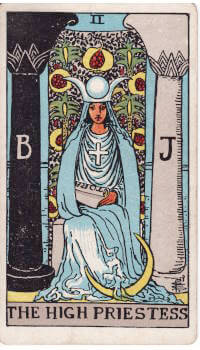
III – The Empress
Femininity, charm, creativity and fertility, high self-esteem, pleasure, independence
Promiscuity, possessiveness, infidelity, greed for power, dependence on others
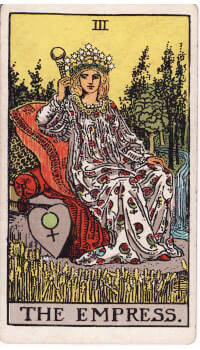
IV – The Emperor
Virility, authority, maturity, bravery, striving for your goals
Immaturity, using others, obdurateness, despotism
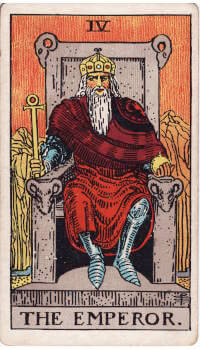
V – The Hierophant
Moral authority, spiritual beliefs, willingness to help, idealism, educating
Religiosity, spiritual crisis, dogmatism, cynicism, superiority complex, phoniness
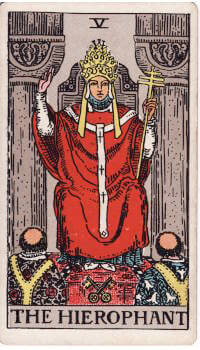
VI – The Lovers
Love, finding a partner, taking responsibility for one’s own life, gaining independence, growing up
Fear of adult life, envy, difficulties in making decisions, disharmony
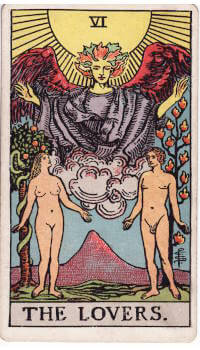
VII – The Chariot
Success, determination, dynamicity, action, willpower
Ruthlessness, arrogance, suffering losses, brutality
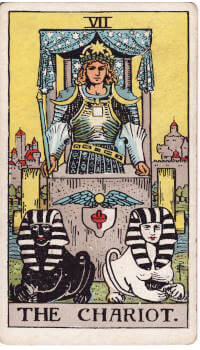
VIII – Strength
Internal strength, sexuality, vitality, accepting oneself, passion
Lack of willpower, sickness, hopelessness, resignation
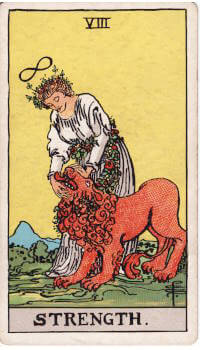
IX – The Hermit
Wisdom, calmness, reflection, reconsidering your choices and views
Loneliness, isolation, distrust, seeking solitude, bitterness
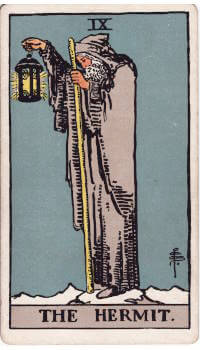
X – The Wheel of Fortune
Prosperity, new opportunities, destiny, luck, a turning point
Bad luck, losses, resistance to change, danger
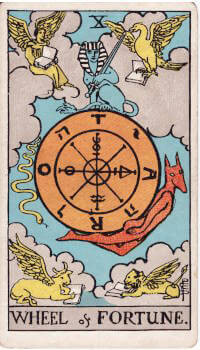
XI – Justice
Balance, tolerance, truth, righteousness, being lawful
Unfairness, fraud, criticism, sense of injustice
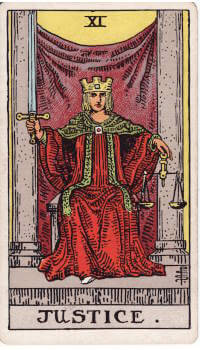
XII – The Hanged Man
Period of waiting, being late, a pause in life, step back from the material world
Resignation, stagnation, melancholy, indifference, crisis
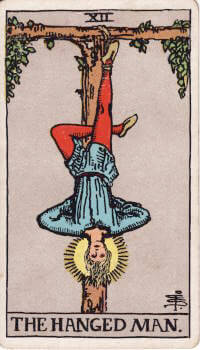
XIII – Death
A significant change, endings, transition, revival, farewell
Fear of change, stagnation, sickness, inner purging
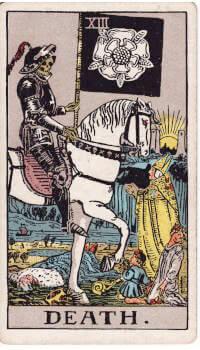
XIV – Temperance
Patience, trust, inner peace, harmony, moderation
Disharmony, disquietude, superficiality, internal conflict
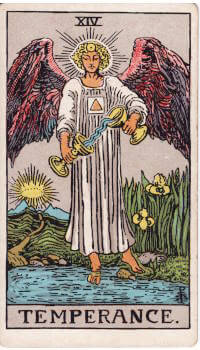
XV – The Devil
Addiction, maleficence, material attachments, seduction, lies
Overusing power, despise, detachment, blasphemy
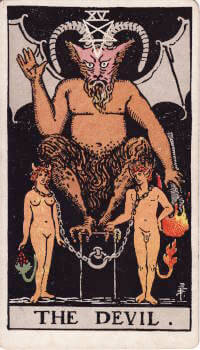
XVI – The Tower
Sudden changes, loss of stability, frustration, revelation, doubts
Overacting, inability to change, desolation, self-destructive behavior, inertia
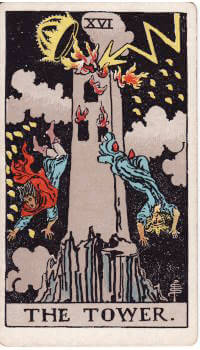
XVII – The Star
Faith, hope, optimism, health, love, security, vital strength
Despair, loss of hope, resignation, pessimism, disconnection
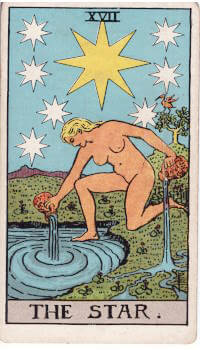
XVIII – The Moon
Lack of clarity, intuition, fantasy, unconsciousness, enigma
Mental instability, nightmares, toxic relations, repressed emotions
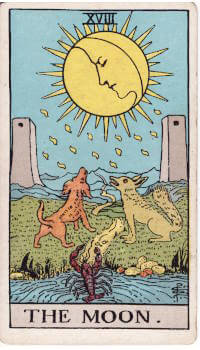
XIX – The Sun
Happiness, joy, fun, success, new beginnings, strength to start anew
Disappointment, inability to leave the past behind, pessimism, feeling down
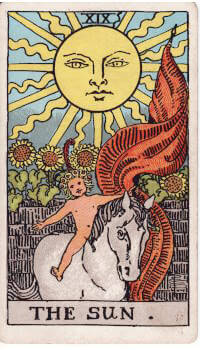
All these cards’ meanings might seem like a lot of memorization, but hey, do you recall what was said about the importance of subjectivity? It is still the most important component of any reading. Sure, these keywords for each Major Arcana card stem from a long tradition of the cards’ symbolism. Still, once you uncover a card and feel that it “speaks” to you on a personal level, you shouldn’t preoccupy yourself too much with the canonical meanings. Since these keywords are somewhat vague and ambiguous, try not to perceive them as some sort of absolutes. For instance, the upright reading of the seventh card, The Chariot, has “success” as one of the keywords. Instead of treating it as a prediction of achieving everything you want on all planes of life, try to relate it to your current situation. Maybe you’ve been working hard for a promotion. Perhaps you’re concluding an important project or having a crucial meeting soon. It might also pertain to a much less significant matter that is nonetheless relevant to you at the given moment. Seek the connections between the cards and your experiences. It is also vital to consider the position of the card in a given spread.
Now that you’re acquainted with the implications underlining each card of the Major Arcana, it’s time we turned to the larger set. As has been established, Minor Arcana provide us with insight into our daily lives and relatively mundane undertakings. However, it includes 56 cards, making it almost impossible for a beginner to master all the meanings (remember that they also might be read in two positions, rendering 112 meanings!). Thus, here, we will limit ourselves to a brief description of each suit.29
Suit of Wands: Spirituality
Ace of Wands
Strength, vitality, virility, inspiration, positive attitude, ambition
Egocentrism, greed for power, negative attitude, hostility
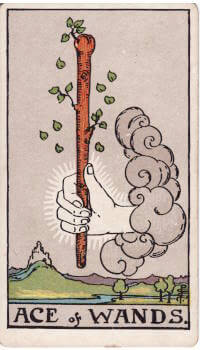
2 of Wands
Deserved success, authority, inner strength, independence
Arrogance, rivalry, pride, feeling of being undervalued, criticism
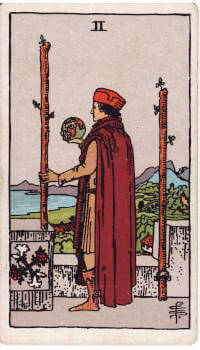
3 of Wands
Reconciliation with the past, support, maturity, setting a goal
Being haunted by the past, stagnation, financial problems, distrust
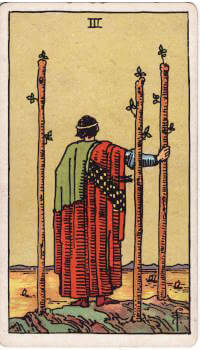
4 of Wands
Optimism, celebration, relaxation, animal spirits, fulfillment of plans
Delay in reaching your goals, argument, perfectionism, tensions, inability to see the positive side
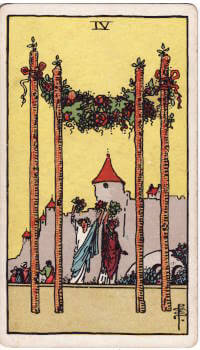
5 of Wands
Total engagement in realization of goals, readiness to act, competitiveness, testing your strengths
Waging a treacherous, unfair struggle, fraudulence, brutality, readiness to do whatever it takes to reach a goal
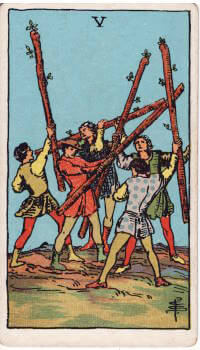
6 of Wands
Triumph, pride and happiness, being recognized, good news, progress, turning point in life
Treason, bad news, late delivery, Pyrrhic victory, blocking other’s successes, the feeling of being undervalued
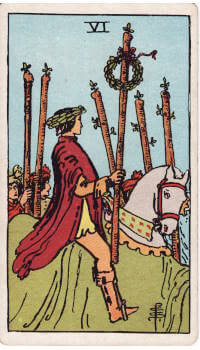
7 of Wands
Proper course of action, struggle from a solid standpoint, fulfilling your needs, decisiveness
Struggle for power, exhaustion, constant need to be tested, fear of own power
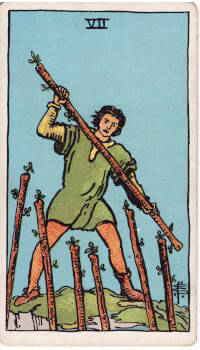
8 of Wands
Movement, acting quickly, an avalanche of events and information, romance
Intolerance, depression, passivity, obstacles on the information flow
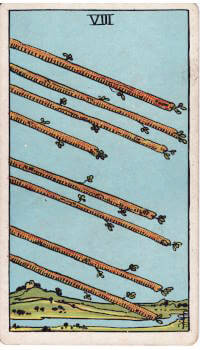
9 of Wands
Resilience, distrust, need to take a break, defensive stance, stabilization
Feeling overwhelmed, misfortune, health problems, perfectionism, material losses
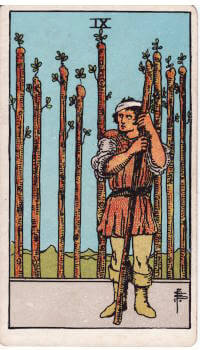
10 of Wands
Completing a difficult task, being overburdened with work and responsibilities, need to take a break
Destructive jealousy, lies, deception, doing everything on your own
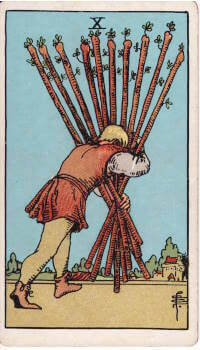
Page of Wands
Inspiration, ideas, discovery, limitless potential, being a free spirit
Newly formed ideas, redirecting your energy, having self-limiting beliefs, going down a spiritual path
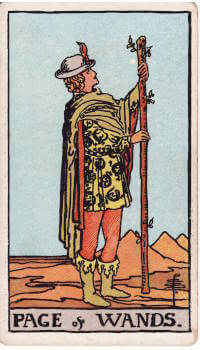
Knight of Wands
Energy, passion, inspired action, adventurousness, impulsiveness
A passionate project, haste, scattered energy, delays, frustration
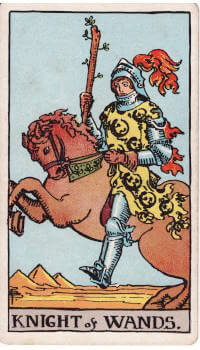
The suit of Wands corresponds to the suit of Clubs among the French-suited cards. Each Minor Arcana suit is related to one of the four cardinal elements (fire, water, air, earth) governing various aspects of ourselves. In the case of Wands, this element is fire, which is hot, unpredictable, wild, and potentially devastating. When controlled, however, fire may be used for our benefit, just as our zeal and determination, for which the suit of Wands stands.
Wands pertain to our passion, enthusiasm, adventurousness, youth-like optimism, and drive to take action. If you see Wands appear in your reading, look for answers to your questions relating to the conscious core of your existence – your personality, what makes you tick, your ego, your internal energy. Suit of Wands also indicates new beginnings, whatever such a “beginning” may currently mean to you. Court cards of this suit represent people around you who were born under one of the “fire” astrological signs, i.e., Leo, Sagittarius, or Aries.
Positive readings of Wands indicate creativity, initiative, and confidence on your part. Currently, you’re charismatic, energetic, and somewhat spiritual. You prefer to seek greater purpose and meaning in life than what is directly perceptible. On the other hand, negative readings suggest that you may be too self-centered, forceful, or impulsive. Perhaps you lack long-term purpose or direction in some issues, which leaves you with a sense of meaninglessness and frustration.
Suit of Cups: Emotions
Ace of Cups
Unexpected gift, love, friendship, creativity, trust in higher powers
Emotional concerns, anxiety, unrequited love, feeling of senselessness, low self-esteem
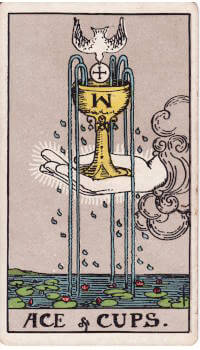
2 of Cups
Meeting an expected partner, balance between intuition and reason, self-acceptance, a positive atmosphere around you
Arguments, misunderstandings, jealousy, discrepancy between what you feel and what you do
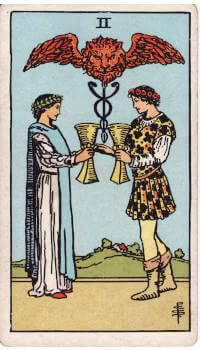
3 of Cups
Celebration, new beginnings, finishing ongoing projects, luck in emotional affairs, gratitude
Immorality, illness, gluttony, premature celebration, disappointment, bitterness
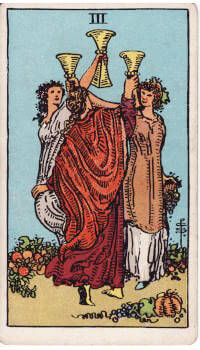
4 of Cups
Sadness, weariness, disappointment, dilemmas in love life, inability to perceive chances and possibilities, apathy
Expecting too much from life, isolation, feeling undervalued, concentrating on the negative aspects of life
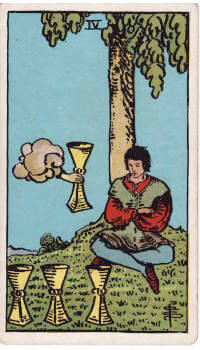
5 of Cups
Loss, breakup, grief, tears, farewells, solitude
Disintegration of past life, emotional loss and the inability to reconcile with it, difficulties in accepting changes
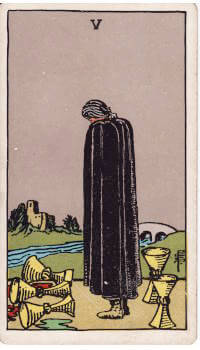
6 of Cups
Revisiting the past, childhood memories, faith, readiness to forgive, longing for the past life
Rejecting the need to mature and take responsibility, fear of living, lack of confidence, high expectations
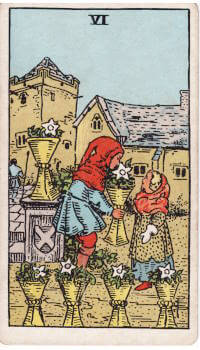
7 of Cups
Fantasy, dreams, new possibilities, utilizing the power of subconsciousness, difficulties in decision-making
Illusory life, running away from responsibilities, tendency to overuse substances, idealizing others and yourself, inability to set your priorities
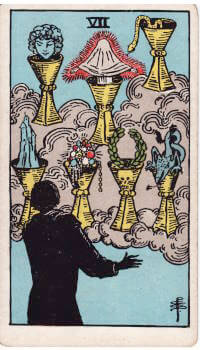
8 of Cups
Inner reflection, getting to know your needs and balance, being sincere with yourself, journey into the unknown, going down your own path
Unreasonable expectations, retreat into oneself, loss of faith, running away from life, refusal to leave or change something
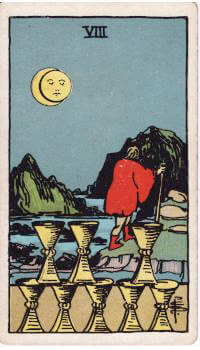
9 of Cups
Feeling content and satisfied, financial security, material success, repletion, hospitality, being social and outgoing
Discontent with oneself, lack of initiative, gluttony, overusing someone’s hospitality, materialism
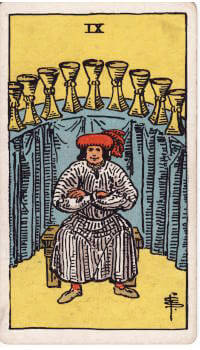
10 of Cups
Familial happiness, fulfillment in family life or relationship, realizing your dreams, sympathy with others
Unfulfilled love, missing having a family, lack of familial happiness, setting unreasonable demands
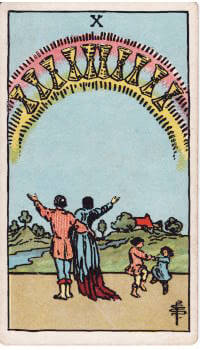
Page of Cups
Creative opportunities, intuitive messages, curiosity, possibility
New ideas, doubting intuition, creative blocks, emotional immaturity
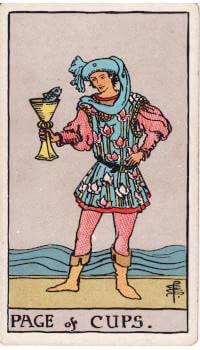
Knight of Cups
Creativity, romance, charm, imagination, beauty
Overactive imagination, being unrealistic, jealous, and moody
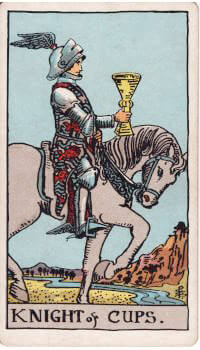
Among the French-suited cards, the suit of Cups corresponds to Hearts. It is associated with the element of water, and its court cards represent people who bear the astrological signs traditionally connected to water, that is, Pisces, Cancer, and Scorpio.
Cups predominantly tell us about our emotional lives. They pertain to feelings, emotions, romanticism, and interpersonal relationships. Whenever this suit dominates your reading, the emphasis must lay on the search for solutions to problems stemming from the emotional plane of consciousness and your heart’s intricacies. While interpreting the Cups cards, look for guidance in your love life and, more extensively, the realm of emotions, especially in relationships, though not necessarily of romantic nature.
On the positive side, Cups suggest that you’re currently feeling sensitive, delicate, and compassionate. You’re creative and imaginative; following your heart and intuition is the optimal way to go at this point in your life. However, Cups in the reversed position may indicate that you’re behaving overly emotionally; perhaps you’re too immersed in thinking about what could have been and living out your fantasies instead of focusing on what is true here and now. Feelings of being a victim, repressed emotions, the inability to express them, and some sort of fretfulness may also be the case when numerous Cups cards in the reversed position appear.
Suit of Swords: Intellect
Ace of Swords
Power of intellect, ability to think critically, objectivity, seek for truth, clear of thought, making the right choices
Injustice, arguments, need to retaliate, inability to express your thoughts clearly, intellectual blockade
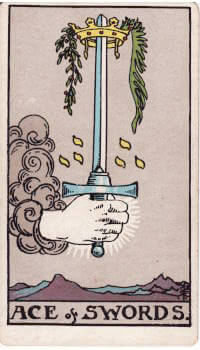
2 of Swords
Ceasefire, disappointment, despair, emotional dejection, listening to your inner self, hostility
Deceit, hypocrisy, ambiguous situations, unfaithfulness, making wrong decisions, intolerance
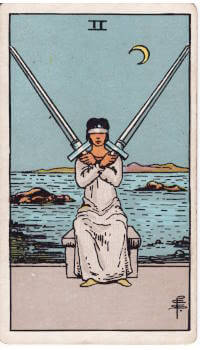
3 of Swords
Feeling hurt, betrayal, conflict, tears, breakup, existential pain, inability to let go
Loss, mourning, controlling your emotions, going back on your word, emotional chaos, jealousy
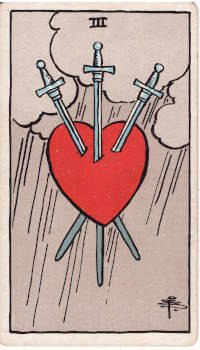
4 of Swords
Withdrawal, isolation, reluctance to contacts with others, dejection, need to take a breather
Coming back to light, frugality, slow recuperation, return to your normal functioning
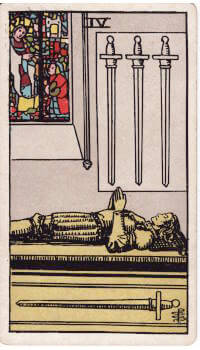
5 of Swords
Loss, defeat, denunciation, having no scruples, deceit, slyness, distrust
Evil, bitterness, despair, a change for the worse, retaliation, demagoguery, intolerance, internal hostility
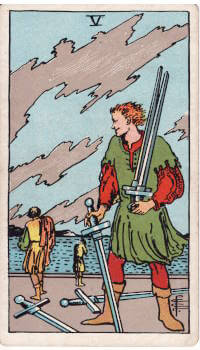
6 of Swords
A journey, either physical or into your own self, spiritual development, a change of place, silence; in combination with 7 or 8 of Coins indicates venturing forth to find something new
Inability to resolve a difficult situation, perfectionism, idealism, aggression, a turbulent period
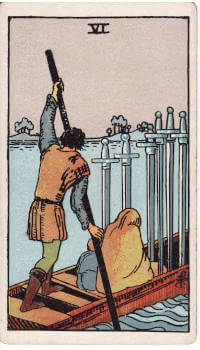
7 of Swords
Deception, arguments, theft, lies, acting alone, shrewdness, secrets, backstage plots, empty words with no meaning
Being overly reliant on others, having your will to act undermined, underestimating the opponent, seeking help among the close ones; if you were dishonest towards someone, it may come back to you
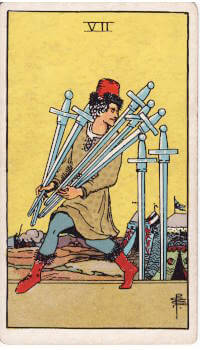
8 of Swords
Crisis, limitations, trap, having no way out, being a captive to your own self, being trapped in negative thoughts, helplessness
Feeling released and salvaged, relaxation, resistance, striving towards mental balance
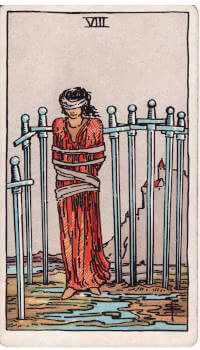
9 of Swords
Sleeplessness, depression, negative thoughts, fear, nightmares, incoming bad news, career crisis, lack of confidence
Grief, loneliness, sickness, blaming others, playing the role of a victim, neurotic disorder, judging others according to your own criteria
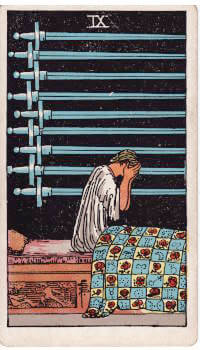
10 of Swords
Sudden adversity, accident, theft, being laid off, breakup or rejection, a chance to “resurrect” and start everything anew
Short-term improvement, sudden change, life at risk, devastating rage, lots of tension, doubting your value and purpose
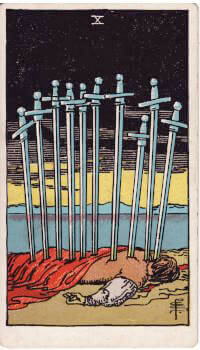
Page of Swords
New ideas, curiosity, thirst for knowledge, finding new ways of communicating
Focusing on self-expression, all talk and no action, acting haphazardly and hasty
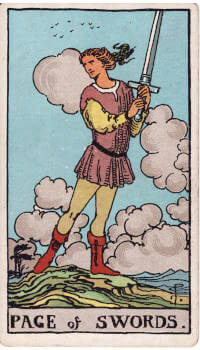
Knight of Swords
Ambitiousness, being action-oriented, drive to success, quick thinking
Restlessness, lack of focus, impulsiveness, burn-out
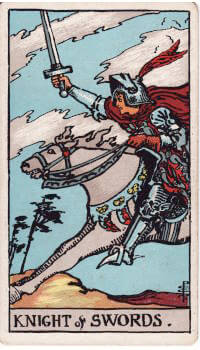
This suit corresponds to the suit of Spades in the regular deck of playing cards. Its element is air: invisible, imperceptible to us, but able to become a forceful wind. So is the case with our intellect and knowledge, which the suit of Swords symbolizes. Symbolism hides in the sword alone; most swords are double-edged and, as such, represent the delicate balance we should achieve between our spirituality (Wands) and emotions (Cups) so that our intellectual capacities (Swords) can reach their full potential. In astrology, air (and, by extension, the suit of Swords) represents the signs of Aquarius, Libra, and Gemini. Following the Swords’ meaning in Tarot, people born under these signs are rational and calculating and prefer to be guided by their reason rather than emotions.
As was established above, cards of the Swords suit tell us about the power of our intellect and clarity of thought. They delve into matters of reason, logical thinking, and ethics. If Swords reoccur often in your readings, see it as an indication that you need to clarify your thinking process. You must make a decision and you want it to be the best one possible. However, Swords tend to carry strong and forceful messages – they often appear as a warning when you should remain particularly cautious and observant about your circumstances.
Upright positioning of Swords indicates that you’re capable of critical thinking, have clarity of thought, and strive for objectivity in dealing with intricate matters. You’re ambitious; you value the search for truth and meticulous preparation for the tests awaiting you. The negative aspects of Swords include lack of compassion, harshness in interpersonal relationships, inability to express your thoughts clearly, indecisiveness, and even vindictiveness.
Suit of Coins (Pentacles): Values
Ace of Pentacles
Material profits, welfare, success, good health, harmony, prolificity, strong will, conscientiousness, persistence
Materialistic approach, leading to spiritual poverty, lack of financial stability, striving for success through lies, deception, and greed
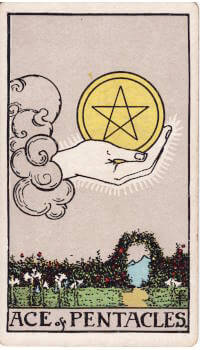
2 of Pentacles
Decision-making, conflict of interest, fun; you should remain cautious while making investments
Light-mindedness, extravagance, incompetence, two-facedness, financial trouble, pretending to be happy
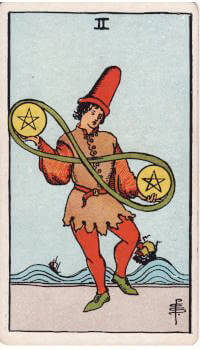
3 of Pentacles
Appreciation at your workplace, career-related success, new opportunities, promotion, profits, self-realization
Chances lost due to being overly cautious, laziness, incompetence, arrogance, inability to take responsibility
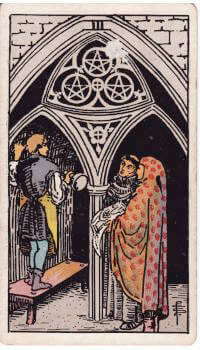
4 of Pentacles
Material stability, increasing influence, workaholism, taking pride in your possessions, overvaluing physical belongings
Lack of authority, financial losses and adversity, meanness, egoism, finding no joy in life
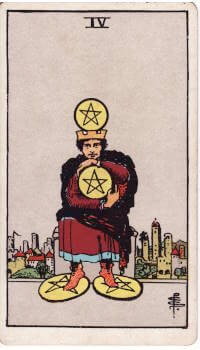
5 of Pentacles
Friend’s support, seeking help, sickness, poverty, financial problems, injustice, life crisis, bad luck
Undoing, misery, unemployment, mental breakdown
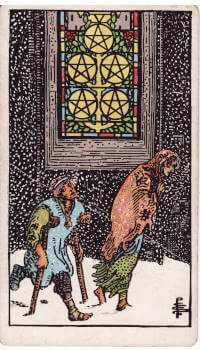
6 of Pentacles
Financial success and safety, receiving gifts and commendation, prize, generosity, readiness to help others
Loss, envy, a quid pro quo attitude, exerting control, losing money and honor
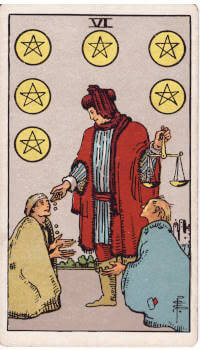
7 of Pentacles
Expecting results, experiencing delays, time to unwind and rest; remain patient and don’t rush anything too much
Laziness, dissatisfaction at work, inability to find your place, feelings of insecurity and fear, impatience, loss of hope for change
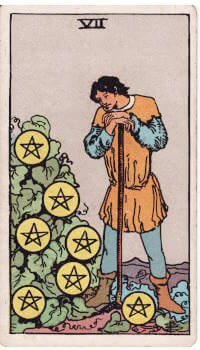
8 of Pentacles
Attentiveness, conscientiousness, industriousness, dexterity, well-earned profits
Lack of focus at work, frustration, laziness, impatience, envy, entering shady deals
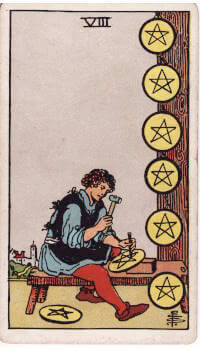
9 of Pentacles
Discipline, financial security, profits, trusting yourself and others, setting goals and priorities, consequently striving towards your goal
Lack of discipline, doubts, inability to describe your needs, not having your priorities straight, irresponsibility
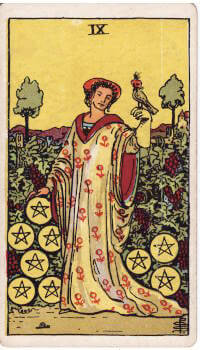
10 of Pentacles
Well-being, stability in professional and family life, time to make changes in your private life
Problems with testaments and inheritance, money-induced arguments, spiritual void, isolation
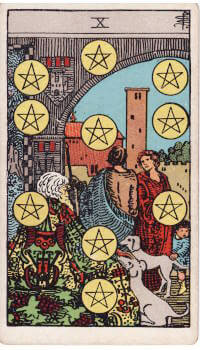
Page of Pentacles
Manifestation, financial opportunities, development of your skills
Stagnation, procrastination, learning from your failures
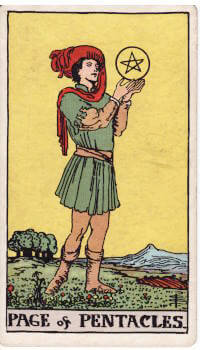
Knight of Pentacles
Hard work, productivity, finding your routine, conservatism
Self-discipline, boredom, feeling stuck, perfectionism
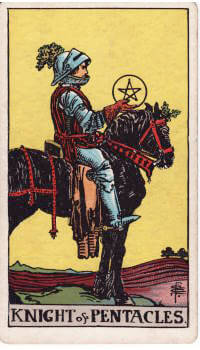
The French-suited counterpart of Coins (or Pentacles) is the suit of Diamonds. This last Minor Arcana suit is related to the element of earth. Coins, being a material good, primarily inform us about things related to value: both material possessions and the moral principles that we develop and adhere to throughout our lives. By extension, Coins may also pertain to our self-esteem, the Ego, and overall, how we perceive ourselves. Among the Zodiac signs, Coins stand for Taurus, Virgo, and Capricorn, which are usually down to earth, calculating, and focused on self-development.
Although the Coins’ implications may go beyond the material world, most classic interpretations will first and foremost mention the physical, tangible sphere of life. After all, this suit is associated with the earth, which is substantial, palpable, the foundation from which all else grows. If you stumble upon it in your readings, look for insight into the practical dimension of your life – the actions you undertake and the results they bear. Try to connect what you see with your current situation at work, your financial status, and the things you physically own. Consequently, Coins also unveil our concerns and internal conflicts related to money or career.
As for the cards’ positive meanings, they include upcoming benefits, well-being, fulfillment of one’s plans, satisfaction, and the effects of one’s work coming to fruition. On the downside Coins may signal excessive focus on material pursuits, which leads to neglecting other aspects of life. Beware of greediness, striving for your goals by any means necessary, cheating for profit, and, in general, being blinded by money.
Whew! This overview must’ve been a healthy amount of information to take in. Luckily, it seems that you finally know all the basics you need to begin with some serious readings that include multiple cards at once. Let’s not postpone this moment any further – it’s time for your first spread!
Your first spread: the most popular types
Let’s recapitulate it all a little. You have your first Tarot deck, you’ve practiced reading single cards for some time, you’ve acquainted yourself with their meanings, and now comes the time to start reading several cards simultaneously. How should you go by it? What are the steps to do it in the best way possible?
First, prepare yourself mentally. Some people like to meditate beforehand; some shuffle the cards around and spend some time simply being in their presence, looking at them individually, trying to put their minds on the right track. Whatever you prefer, make sure you calm yourself down and nothing will interrupt your reading—set up a quiet and relaxed environment for yourself. It definitely helps if you maintain a positive attitude. Reading Tarot while you’re not feeling like it or when you’re generally overwhelmed by negative emotions might not be the best idea. What’s crucial is to try to be open. Tarot reading is a tool for personal growth and self-reflection, so be ready to accept whatever you see and think. Once you feel you’re ready, shuffle the cards thoroughly. Remember to shuffle their orientation too! Cards should not only be in a random order but also in a random orientation so that both upright and reversed positions are taken into account. How you do it is up to you. Before drawing the cards, most people prefer to think about or say aloud the question they want to ask. Alternatively, you might want to read the cards without any specific questions in mind. It is completely fine to read Tarot simply to get some general guidance. Once the cards are shuffled, start drawing and arranging them in one of the spreads that you feel best addresses your current needs.30
Three-card spread
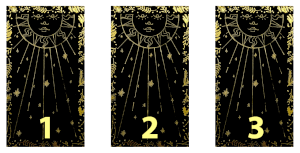
This spread is the simplest to read, as it consists of only three cards, which are supposed to be read from left to right (Figure 13). The readers usually lay it out when they want to gain insight about a specific situation – you think of a question and lay out three cards, one by one. The cards represent the past, the present, and the future, respectively. In other words, whenever you ask about anything, this straightforward spread will tell you what caused it, where you’re now, and what the future holds.
The decision spread
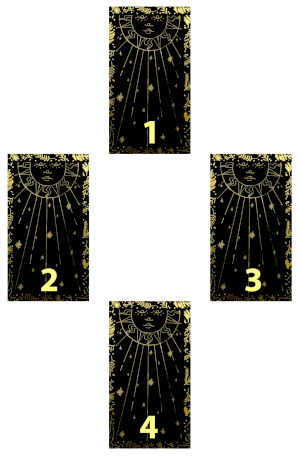
As the name suggests, this spread helps you make the correct decision whenever doubts overshadow your judgment. The cards should be read in the following order: the top one, the left one, the right one, and lastly, the bottom one (Figure 14). The first card gives you the pros of the potential choice A, whereas the second shows its cons. Analogically, the third and fourth serve as indicators of the pros and cons of the potential choice B. If you feel like reaching a definite conclusion is still difficult, you may add a fifth card and place it in the middle – it will be the Tarot’s advice.
The pentagram spread
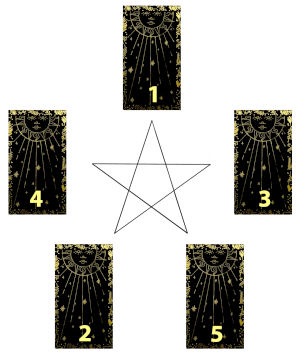
Here, the cards are spread in a way that resembles a five-pointed star (Figure 15). Were we to connect all of them with a line, we’d draw a pentagram, a sacred symbol for various occult traditions. This spread gives you insights into the future but does not merely tell you what awaits you in your upcoming undertakings. Instead, it indicates the origin of the situation you’re trying to understand, the challenges you’ll face on your path, and finally, hints at the steps you should take to reach the desired goal. Hence, you should turn to this spread if you need guidance in what the future holds or are anxious about something specific that you know will happen soon. Start the reading from the star’s top point – this is the origin; this card tells you where you’re coming from. In each turn move by two cards to the left (counterclockwise) or three to the right (clockwise), so for your second card, move all the way down to the bottom left card – this is your destination. From there, proceed to the middle right card – this is the challenge you will have to face down your path. Continue as if you were drawing a pentagram: go to the other side to the middle card on the left. This one represents “clarity.” You intuitively understand what this card represents in your case, although not necessarily consciously. This card helps understand what information is left to obtain to possess a completely clear view on the issue at hand. Finally, look at the card in the bottom right. That’s the goal, the objective you’re trying to obtain. If what you see on this card does not align well with the second card (the one just to the left), perhaps you should reconsider your actions and try a different approach; the steps you’re currently taking may not take you where you wish they did. This spread has several variations. For instance, some people add a sixth card, in the middle of the star, which acts as a significator – it’s a Major Arcana card, removed from the deck before shuffling and chosen specifically to represent the nature of the querent’s issue and guide the reading of the other cards.
The horseshoe spread
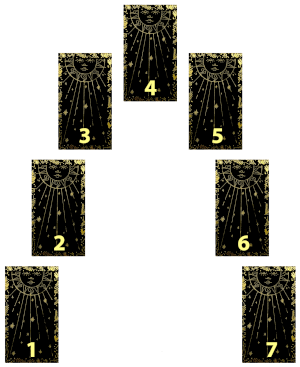
This spread could be described as an extended version of the three-card spread. It also serves well for general readings and is pretty easy to master. Lay down seven cards one by one, starting from the bottom left, moving upwards to the fourth card, and then finishing the spread by going downwards to the bottom right (Figure 16). When interpreting the cards, consider them in the following way: the first three form a single unit, then the top one (number 4) is “isolated” from the rest, the fifth and sixth cards again should be read together, and finally the last one is also isolated. Similarly to the three-card spread, the cards on the left represent a fluid, interconnected course of events: past influences, present circumstances, and the outcomes awaiting in the near future, respectively. The card at the top of the spread provides direct advice, i.e., what you should do to reach a desired result. The following two cards represent other people’s influences on the situation you’re trying to understand and possible hindrances that inhibit your growth. These hindrances might be internal, for instance, your own fears and lack of confidence, as well as external, that is, unfavorable circumstances you happened to find yourself in. Finally, the seventh card encapsulates what all others indicate – this is the outcome of the situation you’re analyzing, assuming the querent doesn’t undertake any measures to alter it. As was the case with the previous spread, if the final card and the “main” one (here, the one on top) do not match, that is, if the final outcome seems undesirable, treat it as a sign that you should change something to avoid disappointment; the other five cards tell you what it is.
The Celtic cross spread
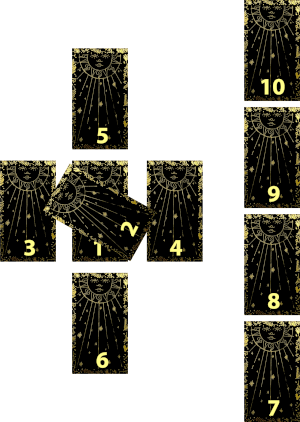
Lastly, we will briefly describe the so-called Celtic cross. This spread is, without a doubt, the most complex among the popular spreads. Still, it’s very beneficial to learn since it allows for a deep insight into your circumstances. Start in the middle of the cross, laying a card vertically and putting another one horizontally on top of it. Then, around this center, add four cards in the following order: top, bottom, left, and right. The final four cards will form a vertical “line,” also called “the pillar,” right of the cross. Go from bottom to top (Figure 17).
The reading goes as follows: the bottom card in the middle of the cross is you. It reflects your present situation and how you perceive it; it highlights the relevant aspects of your current mental state, including the subconscious. The one laid horizontally is the immediate challenge – it literally crosses you on the spread, representing what’s crossing your path of development in life. When combined with the cards on the left and right, a story unfolds – on the left are the past influences that have led to your current state and challenges (cards in the middle) and will further lead to the outcome presented on the right. The cards above and below should align in interpretation for your desired goal to be fulfilled. The card above representing you (number 3 in Figure 17) stands for what you’re consciously aware of, what you’re working for. The card below “you” (number 4) is your subconsciousness: your underlying motivations that you’re most probably unaware of. In this spread, it is an essential card. If it contradicts your conscious goals, treat it as a strong sign that things must change. Then, move on to the following cards which form the pillar. The bottom card of the pillar gives you direct advice for your future actions, much like the fourth card from the horseshoe spread, whereas card 8 hints at external influences affecting your state of mind. Specifically, number 8 focuses on other people’s impact on your situation, the influence that remains beyond your control. Further up (card 9), Tarot delves into your subconsciousness but is much more concrete than card number 4. It provides insight into your fears and hopes and points out what sort of further development scares you, even though you might hope for it. Remember that what you fear may simultaneously be what you wish for, especially if you don’t like changes. Finally, the last card again represents the outcome of the queried situation, based on the assumption that nothing will change on your part.
Frequently asked questions
What is the best deck for a beginner? If you search the web a little, you’ll quickly see that many articles recommend the Rider-Waite deck, sometimes also called “Rider-Waite-Smith.” This deck is also visible in some of the pictures in this article. The reason for that is straightforward – it’s the most common, the easiest-to-get deck today. While this deck’s advantage is that it preserves classic symbolism and easy-to-read imagery, it’s not the only one suitable for a beginner. There’s also the Marseilles deck, designed in the 18th century, the Morgan-Greer deck, and the Thoth deck. Moreover, you can buy a deck inspired by books, movies, TV series – anything you please. We won’t recommend any specific decks for you. As with readings, this part is also highly subjective. You should not choose one deck over the other only because it’s more common or because some website has told you to; you should go for the one that attracts you the most. The design should resonate with you; you should feel comfortable handling the cards. Your purpose as a Tarot reader is to read the stories contained in the cards, so choosing a deck that really speaks to you is very important.
How do I store my cards? Take care of them and treat them with respect. Tarot is supposed to help you understand yourself. Keep the cards clean and tidy. Some advise to store them in a pouch bag with a string in a safe and private place. Those who believe in the power of crystals like to keep one in the bag with the cards (quartz, selenite, or amethyst) because it’s supposed to keep bad energy away from the deck and cleanse it. Additionally, some tarotists burn incense before or after a reading to clean the deck ritually. Overall, we strongly suggest you try your best to handle your cards carefully. After all, they represent you and your life.
Can I buy my own deck? You might find different opinions on the web. Some mystics say that you should never purchase the cards for yourself. Instead, someone has to give them to you. However, the Tarot-reader Rachel Howe says the following thing, and we confidently subscribe to her view: “I’ve heard people say you’re not supposed to buy your own deck, you’re supposed to have someone gift it to you. My feeling is, I bought my deck and I can read. What if no one buys you a deck? Then you never get to learn how to read! Anything that feels like it’s a sort of boundary between people who know and people who don’t know, I don’t think applies anymore.”31
Are there other spreads I might use? The number of spreads you can find online is huge – they are meant to serve slightly different purposes or are simply different versions of the spreads described in this article. The most important thing you should take into account while choosing a specific spread is whether you feel it actually fits your needs and whether you feel comfortable using it (e.g., are you experienced enough to handle a spread with a lot of cards being read at once). What’s more, if you feel confident enough, you may even design your own spreads! Throughout the article, the subjective part of reading Tarot was underlined on several occasions, and this time is no different. Tarot is a tool for self-development, and so if a spread you devised helps you develop – just go for it.
Can I do anything else to help me in my Tarot journey? Here, we’d recommend two things – a Tarot journal and meditation. Keeping track of your readings and interpretations is beneficial in the long term. It was already mentioned that it helps you initially, but it’s also useful later. A journal assists you in better introspection and seeing how your readings develop over time. Sheer looking at your older readings may provide a solid insight into your personal growth. As for meditation, it is purely a matter of training yourself to detach from “here and now.” Being overly preoccupied with your current circumstances while reading Tarot may prevent you from deciphering everything it tries to convey. Meditating right before reading is definitely advisable.
Are there any exemplary readings to help me practice? We haven’t included any readings here, but you may find them easily on the web. For instance, check out the following exemplary readings based on hypothetical situations, which employ some of the spreads described in this article. You can find readings of a Celtic cross spread on the “Truly Teach Me Tarot” or “The Tarot Lady” websites, whereas the former site contains also a reading of a horseshoe spread (notice the slightly modified version of the spread being used).
Cited Works
Antonowicz-Wlazińska, B. (2003). Vademecum Tarota. Białystok: Studio Astropsychologii.
Daynes, D & Sarian, F. (2000). Le Tarot, ses règles et toutes ses variantes. Paris: Bornemann.
Decker, R., Depaulis, T., & Dummet, M. (1996). A Wicked Pack of Cards. The Origins of the Occult Tarot. London: Duckworth.
Dummet, M. (1980). The Game of Tarot. From Ferrara to Salt Lake City. London: Duckworth.
Lévi, É. (1896). Dogme et Rituel de la Haute Magi Part I: The Doctrine of Transcendental Magic. Translated by A. E. Waite. London: Rider & Company.
Madajczak, J. (2023, September 4). “Who invented playing cards? The history of the 52-card deck.” Solitaires Online. https://solitaires-online.com/history-of-playing-cards/.
McIntosh, Ch. (1975). Eliphas Lévi and the French Occult Revival. Albany, NY: SUNY Press.
Nichols, S. (1980). Jung and Tarot. An Archetypical Journey. San Francisco/Newburyport, MA: Weiser Books.
Pratesi, F. (1989). “Italian Cards – New Discoveries.” The Playing Card 18: 28-38.
Yotka, S. (2016, August 4). “Tarot 101: A Beginner’s Guide.” Vogue. https://www.vogue.com/article/tarot-101-beginner-guide-how-to-small-spells.
List of Figures
- Fool (La Folie) from Etteilla’s tarot deck. Wikimedia Commons, public domain.
- Tarot player with Austrian Tarot cards (Industrie und Glück pattern) during a game. Wikimedia Commons, Attribution-ShareAlike 3.0 Unported.
- The magician card from the Pierpont-Morgan Bergamo Visconti-Sforza Deck, mid-15th century. Wikimedia Commons, public domain.
- Reproduction of 3 cards from the Pierpont-Morgan Bergamo Visconti-Sforza Deck. Wikimedia Commons, public domain.
- Corpus Hermeticum: first Latin edition, by Marsilio Ficino, 1471. Currently at the Bibliotheca Philosophica Hermetica in Amsterdam, the Netherlands. Wikimedia Commons, public domain. © Bibliotheca Philosophica Hermetica, Amsterdam.
- Image of Antoine Court de Gébelin in 1784, unknown author. Currently at Bibliothèque Nationale de France (information extracted from: Decker, Depaulis, & Dummet 1996: 149). Wikimedia Commons, public domain.
- Plates III and V from A. Court de Gébelin, Monde primitif, vol. VIII, 1781. Currently at the Bibliothéque Nationale de France. Original composition by: Decker, Depaulis, & Dummet 1996: 149, fig. 1b. © (information extracted from: Decker, Depaulis, & Dummet 1996: 149). Bibliothéque Nationale de France.
- Engraving of Mercurius [Hermes] Trismegistus from Pierre Mussard, Historia Deorum fatidicorum, Venice, 1675. Wikimedia Commons, public domain.
- Etteilla at work, from his Cours théorique et pratique du livre de Thot (1790). Wikimedia Commons, public domain.
- The Major Arcana Tarot cards in a Qabalistic Tree of Life. Wikimedia Commons, Attribution-ShareAlike 3.0 Unported.
- The Devil from Leigh McCloskey’s Tarot ReVisioned. Wikimedia Commons, Attribution-ShareAlike 4.0 International License.
- Exemplary Tarot cards in a spread. Wikimedia Commons, Attribution-ShareAlike 4.0 International License.
- Three-card Tarot spread. Drawn by Karolina Juszczyk, custom cards created by Aleksandra Rykowska.
- Four-card Decision Tarot spread. Drawn by Karolina Juszczyk, custom cards created by Aleksandra Rykowska.
- The Pentagram Tarot spread. Drawn by Karolina Juszczyk, custom cards created by Aleksandra Rykowska.
- The Horseshoe Tarot spread. Drawn by Karolina Juszczyk, custom cards created by Aleksandra Rykowska.
- The Celtic Cross Tarot spread. Drawn by Karolina Juszczyk, custom cards created by Aleksandra Rykowska.
The images of individual cards on the graphics all belong to the Rider-Waite deck and all were extracted from Wikimedia commons, public domain.
End notes
- ^ Dummet 1980: 7.
- ^ Antonowicz-Wlazińska 2003: 21, 62-64.
- ^ Decker, Depaulis, & Dummet 1996: 40.
- ^ Dummet 1980: 65-66.
- ^ Pratesi 1989.
- ^ Decker, Depaulis, & Dummet 1996: 25.
- ^ Madajczak 2023.
- ^ Decker, Depaulis, & Dummet 1996: 30.
- ^ Dummet 1980: 191.
- ^ Daynes 2000: 6.
- ^ Decker, Depaulis, & Dummet 1996: 20.
- ^ https://en.wikipedia.org/wiki/Rosetta_Stone.
- ^ Decker, Depaulis, & Dummet 1996: 57-58.
- ^ Court de Gébelin 1781; extracted from: Decker, Depaulis, & Dummet 1996: 58.
- ^ Decker, Depaulis, & Dummet 1996: 60.
- ^ Decker, Depaulis, & Dummet 1996: 68.
- ^ Decker, Depaulis, & Dummet 1996: 68-71.
- ^ Decker, Depaulis, & Dummet 1996: 72-73.
- ^ Decker, Depaulis, & Dummet 1996: 100-115.
- ^ McIntosh 1975: 73-82, 96-104.
- ^ Decker, Depaulis, & Dummet 1996: 168.
- ^ Lévi 1896: 56.
- ^ Decker, Depaulis, & Dummet 1996: 174.
- ^ Nichols 1980: 22-23.
- ^ Yotka 2016.
- ^ Antonowicz-Wlazińska 2003: 16-18, 20.
- ^ Nichols 1980: 22-23.
- ^ The cards meanings are after Antonowicz-Wlazińska 2003: 62-107.
- ^ The descriptions of suits are after Antonowicz-Wlazińska 2003: 127-165, 193-201 and https://biddytarot.com/tarot-card-meanings/minor-arcana/.
- ^ The descriptions of the following spreads are after: https://culture.org/psychics/how-to-read-tarot-cards/ and https://www.learnreligions.com/tarot-card-spreads-2562807.
- ^ Yotka 2016.

